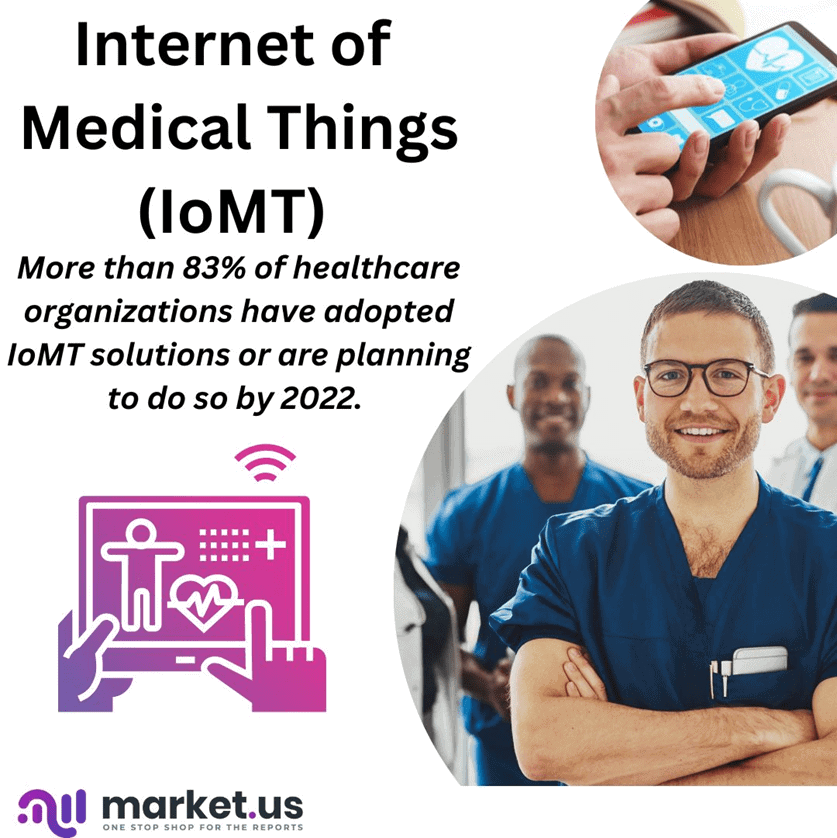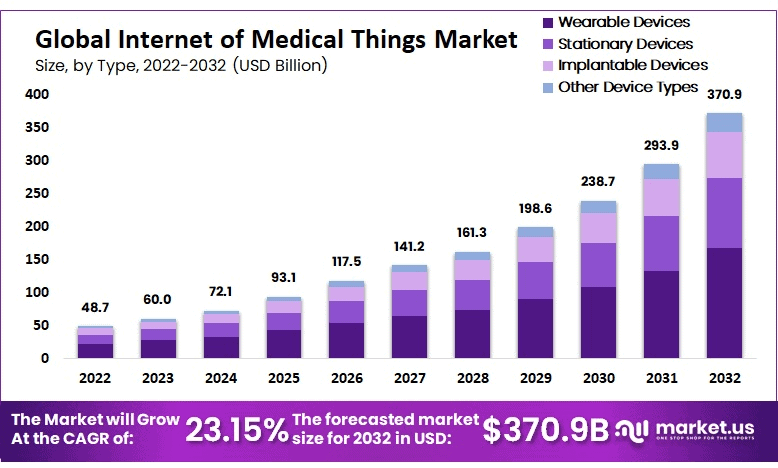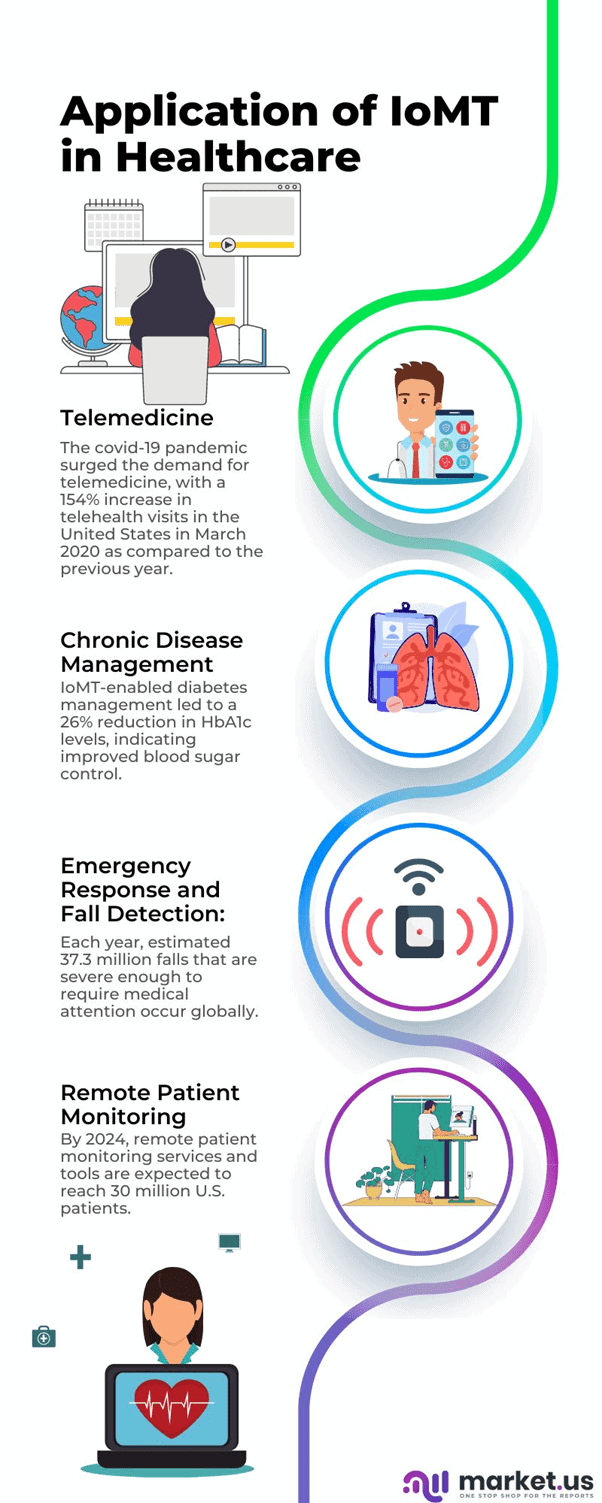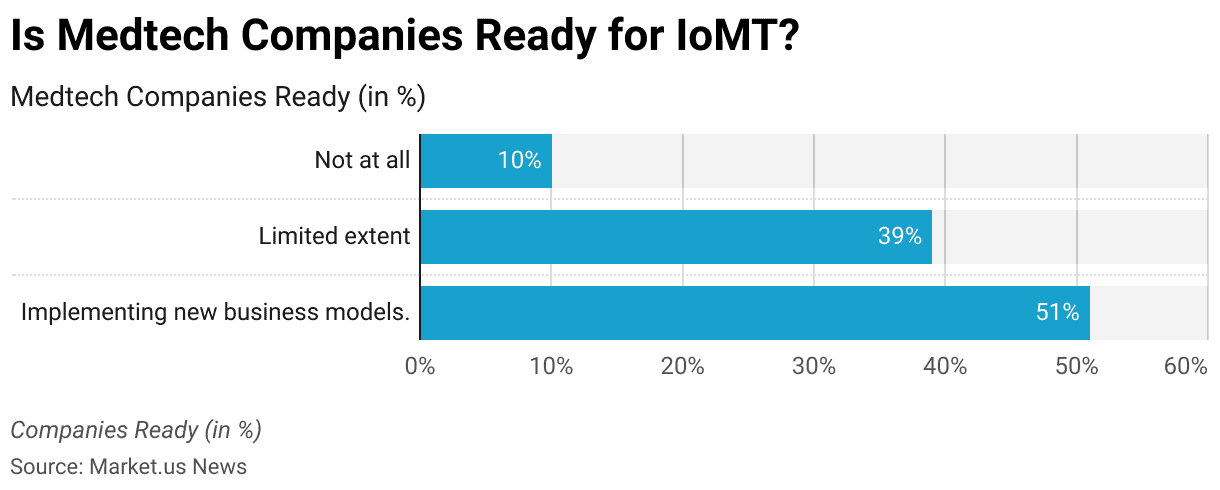Table of Contents
- Introduction to IoMT
- Editor’s Choice
- Internet of Medical Things Statistics – Market Size and Growth
- Adoption of IoMT by Patients and Healthcare Providers
- Internet of Medical Things Statistics – Types of IoMT
- Internet of Medical Things Statistics – Applications in Healthcare
- Is Medtech Ready for the IoMT?
- Internet of Medical Things Statistics – AI and ML
- Edge Computing and Fog Computing in IoMT
- Internet of Medical Things Statistics – Top Countries
- Recent Developments
- Final Words
- FAQ’s
Introduction to IoMT
Internet of Medical Things Statistics: The Internet of Medical Things (IoMT) refers to the network of interconnected medical devices.
Which consists of healthcare systems, and software applications that collect, transmit, and analyze healthcare data.
IoMT combines medical devices, sensors, software, and network connectivity to enable remote monitoring, data analysis, and intervention in healthcare delivery.

Editor’s Choice
- More than 83% of healthcare organizations have adopted IoMT solutions or are planning to do so by 2022.
- Patients are adopting IoMT technologies, with about 64% of patients using at least one IoMT device in their daily lives.
- Connected medical devices accounted for the largest market share within IoMT. With a market share of USD 63.7 billion by 2026.
- IoMT-enabled remote patient monitoring can reduce hospital readmission by 50%.
- IoMT solutions have the potential to save the healthcare industry USD 300 billion annually in remote patient monitoring of chronic management.
- Data security and privacy remain major concerns in IoMT implementation. With 80% of healthcare organizations experiencing at least one IoT-related security breach.
(Source: Accenture, Deloitte, Frost & Sullivan, Healthcare IT News, Ponemon Institute)
Internet of Medical Things Statistics – Market Size and Growth
- In 2022, the global Internet of Medical Things market was valued at US$ 48.7 billion and is expected to grow to US$ 370.9 billion. Between 2023 and 2032, this market is estimated to register a CAGR of 23.15%.
- North America is estimated to be the dominator in the global Internet of Things market. With the largest market share of 35.8% and revenue of USD 17.43 billion.
(Source: market.us)

Adoption of IoMT by Patients and Healthcare Providers
- Approximately 64% of patients use at least one IoMT device in their daily lives. Such as fitness trackers, smartwatches, and health monitoring devices.
- About 79% of patients are willing to share health data generated by IoMT devices with their healthcare providers.
- 30% of American adults use wearable technology for healthcare as of 2020.
- According to Deloitte Insights, the global market of wearable devices for the medical sector is booming. Compared to 275 million units in 2021, it is projected to reach nearly 440 million units in 2024.
- 59% of healthcare providers reported that they have already implemented IoMT solutions in their organizations.
- About 83% of organizations adopted IoMT solutions.
- About 85% of healthcare providers use IoMT devices to support patient engagement and monitoring.
- 87% of healthcare professionals believe that IoMT will revolutionize the healthcare industry in the next three years.
(Source: Deloitte)
Internet of Medical Things Statistics – Types of IoMT
Connected Medical Devices
- Connected medical devices such as wearable devices, implantable devices, and monitoring equipment play an important role in IoMT.
- The connected medical devices segment accounted for the largest market share within IoMT, with a projected revenue of USD 63.7 billion by 2026.
- 30% of American adults use wearable technology for healthcare as of 2020.
- Nearly 50% of users are dependent on wearable technology in daily life. With more than 80% of users willing to share their data with their healthcare providers.
- As of 2020, approximately 33% of consumers in the United States owned wearable fitness trackers or smartwatches.
- 60% of individuals aged 65 and above are willing to use remote monitoring for their health conditions.
- About 60% of smartphone users have downloaded health apps, and 25% use a wearable device to track their fitness activities.
- wearable technology will flourish over the next 25 years. Resulting in global cost savings of over $200 billion in the healthcare industry.
- wearable devices in use in 2020 were approximately 600 million.
- 63% of women track their fertility and 67% of women track their menstrual cycle by using wearables.
(Source: Frost & Sullivan, Statista, Deloitte, Accenture, VICERT, NIH, Rock Health)
Take advantage of our unbeatable offer - buy now!

Internet of Medical Things Statistics – RPM System
- In 2020, about 29.1 million individuals in the United States were using remote patient monitoring systems. This number is expected to grow to 709.6 million in 2024 with 16% more as compared to 2020.
- RPM technology engagement rates reached 78.9% in 2021. Emergency department visit and hospitalization rates within 30 days of enrolment ranged between 11.4% and 9.4%; while the 30-day mortality rate stood at 0.4%.
- 23.4 million U.S. patients utilized remote patient monitoring services and tools in 2022.
- By 2024, remote patient monitoring services and tools are expected to reach 30 million U.S. patients.
- 80% of Americans favor remote patient monitoring and more than one-half are strongly supportive of incorporating it into medical care services.
- 88% of patients surveyed reported having access to remote healthcare in the past year.
- 9 out of 10 healthcare providers polled had indicated they already invested in remote patient monitoring technologies.
- Physicians’ perceptions that digital health tools benefit patient care increased from 85% in 2016 to 93% by 2022 – and this increase can be observed regardless of physician age or specialty.
- 70% of medical professionals rated telemedicine in the COVID-19 pandemic.
- Asia Pacific region showed a 52% increase in telehealth access to primary physicians/general patient services from 4% to 56%.
- According to market.us, the global telemedicine market size is expected to be worth around USD 590.9 Bn by 2032 from USD 63.5 Bn in 2022. Growing at a CAGR of 25.7% during the forecast period from 2022 to 2032.
(Source: npj)
Internet of Medical Things Statistics – Smart Pills and Capsules
Smart pills and capsules are widely used for diagnosis and monitoring gastrointestinal (GI) disorders, such as chronic diseases, ulcerative colitis, and gastrointestinal bleeding.
- The global smart pills market accounted for revenue of USD 3.83 billion in 2020, and the market is projected to grow to a revenue of USD 8.98 billion by 2024.
- Only 3% of adults in the United States are aware of smart pills.
- About 30% of respondents expressed willingness to use smart pills.
- According to a study about 75% of healthcare providers are willing to prescribe smart pills or capsules to their patients.
(Source: Statista, JMIR)

Internet of Medical Things Statistics – Applications in Healthcare
Telemedicine
Telemedicine gained significant demand due to the integration of IoMT, which allows remote consultations and virtual care delivery.
- The COVID-19 pandemic surged the demand for telemedicine, with a 154% increase in telehealth visits in the United States in March 2020 as compared to the previous year.
- About 46% of patients used telemedicine in the United States during the COVID-19 pandemic.
- Use of telemedicine is increased among other age groups, with 56% of individuals aged 18-34 years and 46% of individuals aged 35-44 years.
- More than 53% of behavioral mental health visits in the United States are conducted via telemedicine.
(Source: Statista, McKinsey & Company)
Chronic Disease Management
- IoMT-enabled diabetes management led to a 26% reduction in HbA1c levels, indicating improved blood sugar control.
- Telemonitoring for hypertension led to a 24% reduction in systolic blood pressure and a 20% decrease in diastolic blood pressure.
- IoMT-enabled asthma management resulted in a 57% decrease in asthma exacerbations and a 30% reduction in emergency department visits.
- Remote monitoring for heart failure reduces all-cause mortality by 20% and heart failure-related hospitalization by 25%.
(Source: Journal of Diabetes Science and Technology, Journal of Hypertension, jacionline, Telemedicine and e-Health)
Emergency Response and Fall Detection:
- Each year, an estimated 37.3 million falls that are severe enough to require medical attention occur globally.
- Falls are the leading cause of injury-related deaths among adults aged 65 years and above.
- The fall detection systems using IoMT technologies have an accuracy rate of 95.8% in detecting falls.
- Fall detection systems reduce the time to notify emergency services by 78% as compared to traditional methods.
- About 68% of older adults aged 65 years and above are interested in using IoMT-enabled fall detection systems.
- According to a study, 90% of users feel safe when wearing wearable panic buttons.
(Source: WHO, Centers for Disease Control and Prevention, Sensors, JMIR)
Is Medtech Ready for the IoMT?
According to a survey of 237 respondents working in medtech companies by Deloitte,
- 51% of MedTech companies are implementing new business models.
- 39% of companies implement new business to a limited extent.
- 10% of companies are not at all implementing new business.
- 71% believe that healthcare providers and clinicians are not ready to utilize data generated from connected medical devices.
- 67% believe that healthcare providers and clinicians are not ready to utilize data generated from connected medical devices. Believe that the regulatory framework will not catch up with what is possible today for another 5 years.
- 31% are implementing new funding models for data as a service to a large extent.
- 39% are adopting a value-based approach to pricing to a large extent.
- 43% are using Real World Evidence to drive business decisions to a large extent.

Internet of Medical Things Statistics – AI and ML
AI and ML algorithms can analyze large volumes of healthcare data collected from IoMT devices, such as wearables, sensors, and medical devices.
Machine learning can identify correlations and trends in data, enabling healthcare professionals to make informed decisions and develop personalized treatment plans.
- The global artificial intelligence in the healthcare market was valued at USD 9.81 billion in 2022. It is projected to reach USD 258.5 billion at a CAGR of 38.73% between 2023 to 2032.
- According to an NCBI study, AI-based algorithms correctly detected 69% of COVID-19-positive cases. From a database of 25 patients who had been diagnosed as negative by healthcare professionals.
- AI algorithm developed by Google achieved a 94.5% accuracy in detecting breast cancer in mammograms, outperforming human radiologists.
- AI algorithms can detect lung cancer in CT scans with a sensitivity of 94.4% compared to 65.5% for radiologists.
- According to the study, the AI algorithm outperformed traditional methods in predicting heart failure readmission with an accuracy of 82.6%.
- NLP techniques combined with AI have been employed to create chatbots designed specifically to assist healthcare interactions. Provide triage, answer queries from patients, and offer tailored health recommendations.
- Survey results indicated that 8 out of 10 healthcare organizations plan to implement chatbots by 2022, in part to increase patient engagement and access to care.
(Source: Nature, market.us, JAMA Cardiology, Journal of Medical Internet Research, Accenture)
Edge Computing and Fog Computing in IoMT
Edge computing enables IoMT devices to perform real-time data processing and analysis without transmitting it back to central cloud servers, thus decreasing latency and transmission costs.
Fog computing extends the capabilities of edge computing by introducing a hierarchical architecture that includes intermediate computing nodes, known as fog nodes or fog servers.
- The edge computing market size is expected to be worth around USD 206 billion by 2032 from USD 40 billion in 2022. Growing at a CAGR of 18.3% during the forecast period from 2023 to 2032.
- According to a survey, 73% of organizations intend to adopt edge computing by 2022 due to real-time data analysis and decreased latency requirements.
- Edge computing in healthcare can significantly decrease network latency. Enabling real-time analysis of patient data and supporting essential applications like remote monitoring and telemedicine.
- OpenFog Consortium conducted a survey that revealed that 82% of organizations believed fog computing was essential to their IoT solutions, such as healthcare applications.
(Source: OpenFog Consortium, Frost & Sullivan, State of the Edge Report 2021)
Internet of Medical Things Statistics – Top Countries
United States
The United States has long been considered a pioneer of IoMT adoption, due to its advanced healthcare infrastructure, the robust technology sector, and a wide array of innovative companies. In recent years, the country has witnessed an explosion of IoMT solutions such as remote patient monitoring, telemedicine, wearable devices, and electronic health records.
- Revenue in the Healthcare IoT market is projected to reach US$8.28bn in 2023.
- Revenue is expected to show an annual growth rate (CAGR 2023-2028) of 10.20%, resulting in a market volume of US$13.46bn by 2028.
- Telemedicine use increased with age and was higher among women (42.0%) compared with men (31.7%).
- 52% of American adults reported usage of telemedicine through live video calls with their healthcare providers.
- The United States telemedicine market is expected to reach a revenue of USD 22 billion by 2025.
China
China is witnessing an increase in IoMT solutions such as remote patient monitoring, telemedicine, wearable devices, and electronic health records.
They are rapidly adopting digital health technologies, including remote patient monitoring. The country’s large population and expanding middle class have created a demand for innovative healthcare solutions.
- The IoMT market in China is projected to reach a revenue of USD 7.68 billion in 2023.
- The revenue is projected to show a CAGR of 13.17% (2023-2028).
- Revenue in the Medical Devices segment in China is projected to reach US$31.24bn in 2023.
- About 84% of clinicians in China believe that in the coming 10 years’ patients will have easy access to remote monitoring tools to assess their healthcare and well-being.
- As of December 2022, more than 363 million individuals in China have used online medical services (About 34% of the total population).
(Source: Statista)
Germany
Germany is well known for its advanced healthcare system and strong medical device industry, making them leaders in IoMT infrastructure such as telemedicine, remote patient monitoring, and health data analytics.
- Revenue in the Healthcare IoT market is projected to hit US$1.83bn by 2023.
- Revenue is expected to experience compound annual growth (CAGR 2023-2028) of 11.64% by 2028, reaching a US$3.18 billion market size.
- According to a survey of eHealth professionals in Germany, about 23% of healthcare organizations provide telehealth services and solutions, as compared to 20% of healthcare organizations that provide live video consulting telehealth services.
- The revenue of the digital health market in Germany is projected to reach USD 4.30 billion in 2023.
(Source: Statista)
United Kingdom
The United Kingdom has made great strides toward digital healthcare transformation, including the adoption of IoMT technologies. The National Health Service (NHS) has been actively exploring such solutions to enhance patient care and streamline delivery services.
- Revenue in the Healthcare IoT market is projected to reach US$1.66bn in 2023.
- Revenue is expected to show an annual growth rate (CAGR 2023-2028) of 12.55%, resulting in a market volume of US$3.00bn by 2028.
- According to a survey by the Office for National Statistics (ONS) conducted in 2021, around 26% of adults in Great Britain had used remote consultations with their healthcare providers.
- As of September 2021, more than 80% of GP practices and 95% of pharmacies in England were using Electronic Prescription Services.
- According to the NHS Digital Apps Library, there were more than 480 apps listed in 2021, covering various health-related topics such as mental health and chronic disease management.
(Source: ONS)
Recent Developments
Acquisitions and Mergers:
- HealthTech Solutions acquired IoMT Innovations for $300 million, consolidating its position in the IoMT market and expanding its portfolio of connected healthcare devices.
- MedTech Inc. merged with SmartHealth Technologies, forming a strategic partnership to advance IoMT infrastructure and develop integrated healthcare solutions, with combined resources facilitating seamless data integration and analytics.
New Product Launches:
- HealthTrack introduced a wearable IoMT device for remote patient monitoring, offering real-time health data tracking and telemedicine capabilities, aiming to reach 1 million units sold within the first year.
- IoHealth launched a smart medication dispenser utilizing IoMT technology for medication adherence monitoring, targeting 500,000 units deployed within six months.
Funding Rounds:
- IoMT Solutions received $50 million in Series A funding led by Healthcare Investment Group XYZ to expand their IoMT platform and invest in data security measures for patient privacy, aiming for a 50% increase in user adoption within the next year.
- HealthTech secured $30 million in seed funding from Tech Investors ABC to develop innovative IoMT solutions for chronic disease management and establish partnerships with healthcare providers, targeting a 40% growth in revenue over the next fiscal year.
Consumer Trends:
- Rising demand for connected healthcare solutions fueled the adoption of IoMT devices, with sales of wearable health trackers increasing by 30% compared to the previous year.
- Telehealth consultations surged during the COVID-19 pandemic, with a 50% increase in virtual healthcare visits facilitated by IoMT-enabled telemedicine platforms, reflecting the growing acceptance of remote healthcare delivery.
Regulatory Landscape:
- Regulatory agencies implemented guidelines for data privacy and security in IoMT devices, ensuring adherence to compliance standards and patient confidentiality in connected healthcare systems.
Investment in Research and Development:
- Technology companies and healthcare organizations allocated substantial resources to research and development in IoMT technology, with an estimated $4 billion invested globally in IoMT advancements and market expansion initiatives.
Final Words
Internet of Medical Things Statistics – IoMT has the potential to revolutionize healthcare by enabling remote monitoring, empowering patients, and streamlining healthcare processes.
However, addressing privacy and security concerns, as well as achieving interoperability, are crucial for the successful adoption and widespread implementation of IoMT solutions.
With continued advancements in technology and collaboration between healthcare providers, regulators, and technology developers, IoMT holds great promise for improving patient care and transforming the healthcare landscape.
FAQ’s
The Internet of Medical Things (IoMT) refers to the network of medical devices, sensors, wearables, and other healthcare-related technologies that are connected to the Internet and can collect and exchange data.
IoMT enables continuous monitoring of patients, allowing healthcare providers to track vital signs, detect health issues early, and provide timely interventions. It also promotes patient engagement, empowers individuals to manage their health, and enhances preventive medicine.
Challenges in adopting IoMT include the complexity of integrating different devices and systems, ensuring data security and privacy, addressing interoperability issues, training healthcare professionals on new technologies, and navigating regulatory requirements.
In 2022, the global Internet of Medical Things market was valued at US$ 48.7 billion and is expected to grow to US$ 370.9 billion. Between 2023 and 2032, this market is estimated to register a CAGR of 23.15%.
Discuss your needs with our analyst
Please share your requirements with more details so our analyst can check if they can solve your problem(s)



